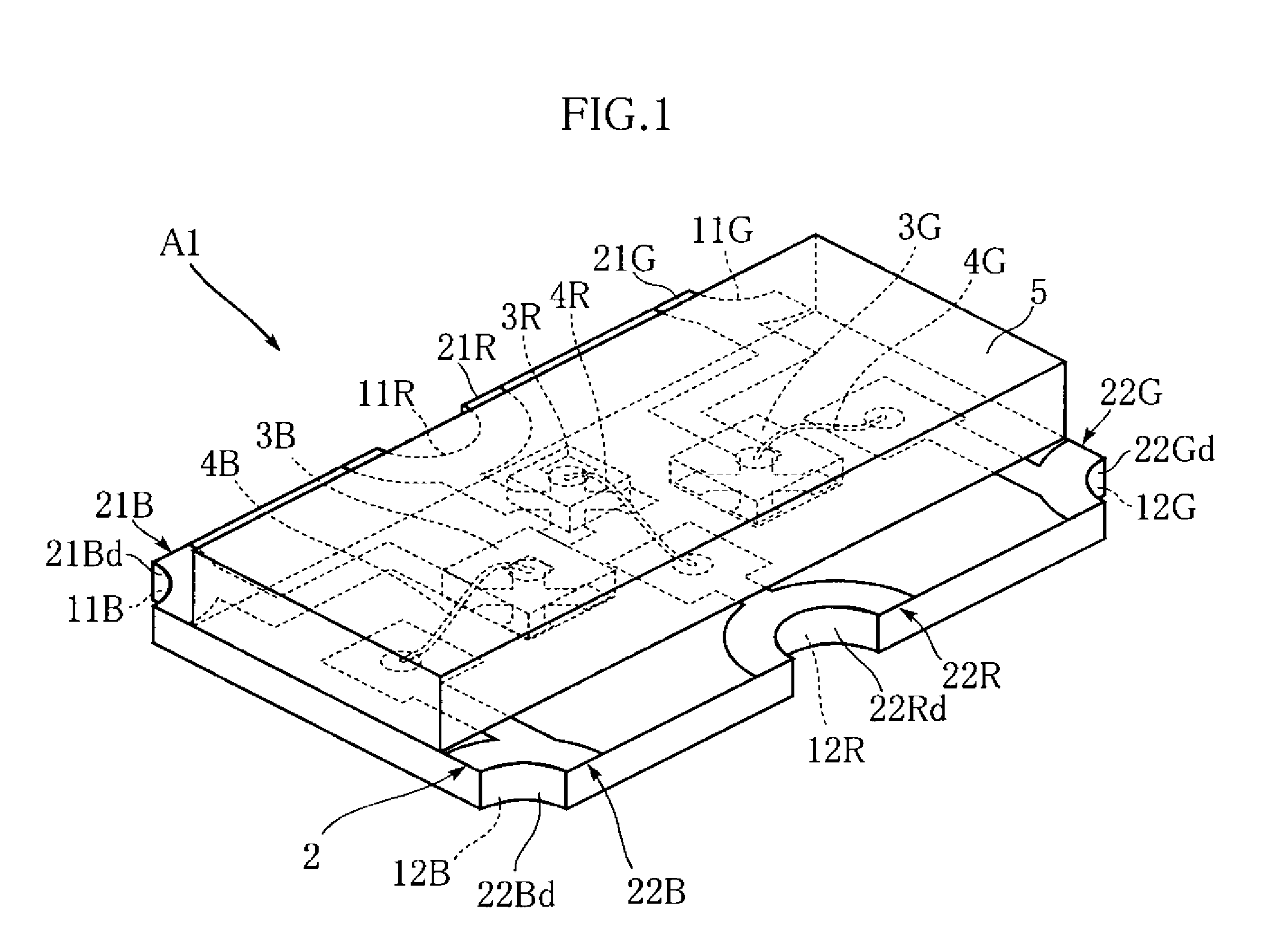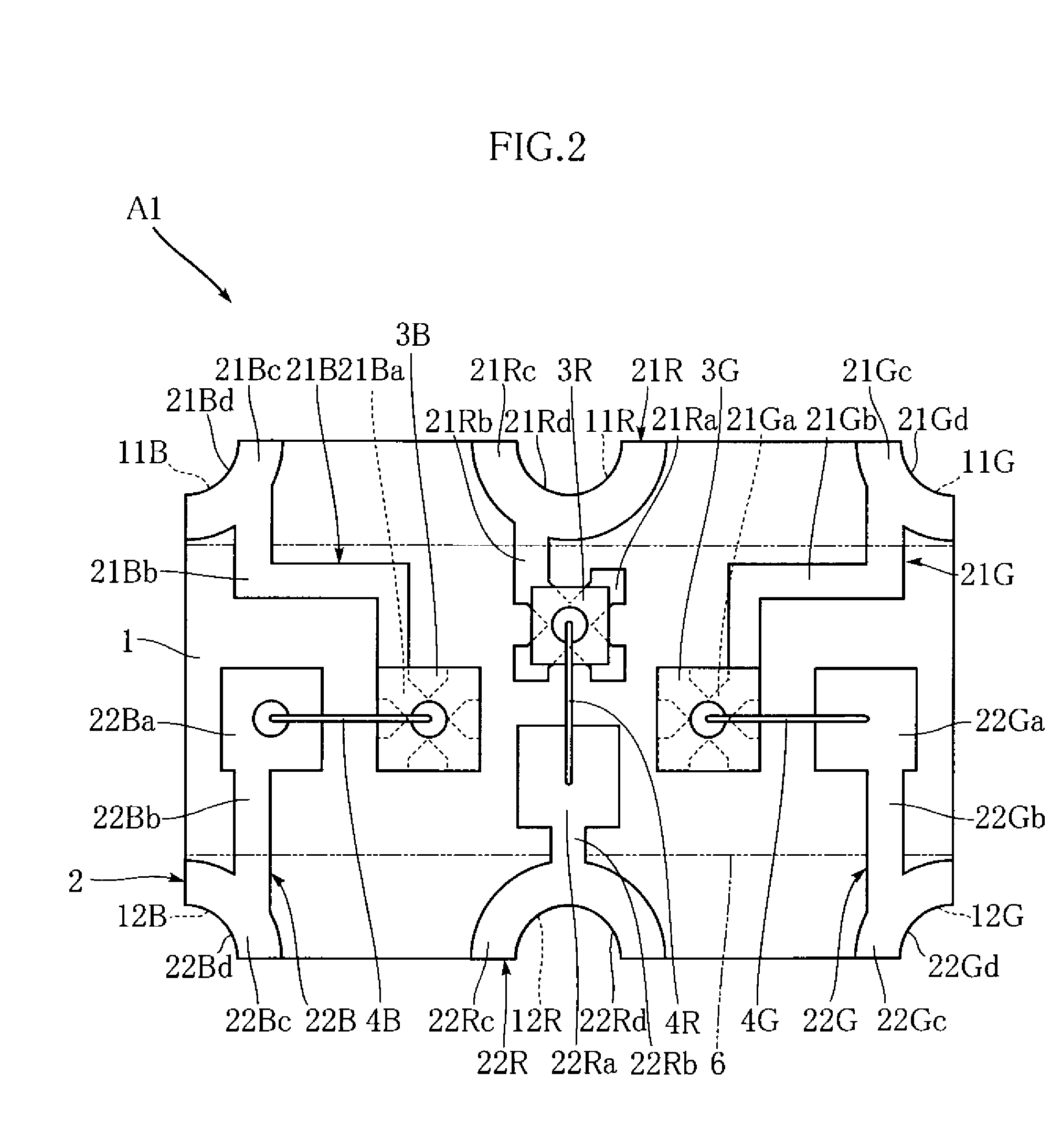LED module and LED dot matrix display
a technology of led modules and led dots, applied in the direction of solid-state devices, lighting and heating apparatuses, lighting support devices, etc., can solve the problems of poor contrast relative to the on-state, difficult arrangement of led chips, etc., and achieve the effect of enhancing contras
- Summary
- Abstract
- Description
- Claims
- Application Information
AI Technical Summary
Benefits of technology
Problems solved by technology
Method used
Image
Examples
first embodiment
[0043]FIGS. 1-3 illustrate an LED module according to the present invention. The LED module A1 of this embodiment includes a module substrate 1, a wiring pattern 2, LED chips 3R, 3G, 3B, wires 4R, 4G, 4B and a sealing resin 5. The LED module A1 is designed to emit white light by mixing red light, blue light and green light. The LED module A1 of this embodiment has a very small size of about 1.0 mm×1.5 mm in plan view and about 0.2 mm in height. For easier understanding, the sealing resin 5 is illustrated by imaginary lines in FIG. 2.
[0044]The module substrate 1 is an insulating substrate made of e.g. glass fiber-reinforced epoxy resin and has a substantially rectangular shape. The module substrate 1 has an obverse surface on which the LED chips 3R, 3G, 3B are mounted, and a reverse surface which is opposite to the obverse surface in the thickness direction. The reverse surface of the module substrate 1 is utilized as a mount surface for mounting the LED module A1. The module substra...
second embodiment
[0060]FIG. 4 illustrates an LED module according to the present invention. The LED module A2 of this embodiment differs from that of the foregoing embodiment in structure of the LED chips 3G and 3B. Specifically, each of the LED chips 3G and 3B includes two electrodes on the upper surface. Thus, two wires 4G and two wires 48 are bonded to the LED chips 3G and 3B, respectively. One of the wires 4G and one of the wires 4B are bonded to the pads 21Ga and 21Ba, respectively. The pads 21Ga, 21Ba of the electrodes 21G, 21B are aligned with the pads 22Ga, 22Ba of the electrodes 22G, 22B in the short-side direction of the module substrate 1, respectively.
[0061]According to this embodiment again, mixing of light from the LED chips 3R, 3G, 3B is promoted, and the size reduction of the LED module A1 is achieved. As will be understood from this embodiment, the present invention is also applicable to an LED module including two-wire type LED chips.
third embodiment
[0062]FIG. 5 illustrates an LED module according to the present invention. The LED module A3 of this embodiment differs from the foregoing embodiments in structure of the LED chips 3G and 3B. Specifically, each of the LED chips 3B and 3G of this embodiment have a flip-chip structure including two electrodes on the lower surface. To correspond to this structure, the pads 21Ga and 21Ba have a horizontally elongated shape to overlap the LED chips 3G and 3B, respectively. The pads 22Ga and 22Ba are arranged next to the pads 21Ga and 21Ba, respectively, in the short-side direction of the module substrate 1. The two electrodes of the LED chip 3G are bonded to the pads 21Ga and 22Ga, whereas the two electrodes of the LED chip 3B are bonded to the pads 21Ba and 22Ba.
[0063]According to this embodiment again, the size reduction of the LED module A1 and mixing of light of different colors are promoted. As will be understood from this embodiment, the present invention is also applicable to an L...
PUM
 Login to View More
Login to View More Abstract
Description
Claims
Application Information
 Login to View More
Login to View More - R&D
- Intellectual Property
- Life Sciences
- Materials
- Tech Scout
- Unparalleled Data Quality
- Higher Quality Content
- 60% Fewer Hallucinations
Browse by: Latest US Patents, China's latest patents, Technical Efficacy Thesaurus, Application Domain, Technology Topic, Popular Technical Reports.
© 2025 PatSnap. All rights reserved.Legal|Privacy policy|Modern Slavery Act Transparency Statement|Sitemap|About US| Contact US: help@patsnap.com



